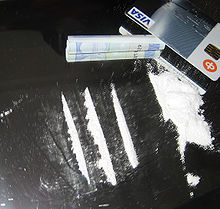

Most banknotes have traces of cocaine on them; this has been confirmed by studies done in several countries.[1] In 1994, the U.S. 9th Circuit Court of Appeals cited findings that in Los Angeles, three out of four banknotes were tainted by cocaine or another illicit drug.[2][3]
Studies indicate that banknotes may serve as a fomite—an inanimate object that can spread disease if contaminated—though researchers disagree over how easily diseases are transmitted by this mechanism.
Several theories have been suggested to explain this contamination beyond the predictable contamination due to handling during drug deals and the use of rolled up notes for snorting drugs. After the initial contamination, the substance is transferred to other notes in close contact, often stacked together, in enclosed environments common in financial institutions.
- ^ "Drug Money". Snopes. 9 July 2002. Retrieved 2008-07-23.
- ^ Abrahamson, Alan (13 November 1994). "Prevalence of Drug-Tainted Money Voids Case Law: Court cites findings that more than 75% of currency in L.A. bears traces of cocaine or other illegal substances". Los Angeles Times. Archived from the original on 2011-06-04. Retrieved 2008-07-23.
- ^ Price, Debbie M. (6 May 1990). "Use of Drug-Sniffing Dogs Challenged;ACLU Backs Complaint by Men Whose Pocket Cash Was Seized". The Washington Post. Retrieved 2008-07-23.[permanent dead link]